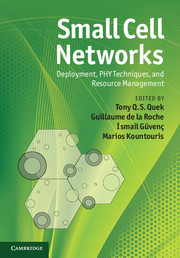Book contents
- Frontmatter
- Contents
- List of contributors
- Foreword by David Chambers
- Acknowledgments
- Acronyms
- 1 Small cell networks overview
- 2 Fundamentals of access control in femtocells
- 3 Coverage analysis using the Poisson point process model
- 4 Interference modeling for cognitive femtocells
- 5 Multiple antenna techniques in small cell networks
- 6 Physical layer techniques for cognitive femtocells
- 7 Femtocell coverage optimization
- 8 Random matrix methods for cooperation in small cell networks
- 9 Mobility in small cell networks
- 10 Cognitive radio resource management in autonomous femtocell networks
- 11 Decentralized reinforcement learning techniques for interference management in heterogeneous networks
- 12 Resource allocation optimization in heterogeneous wireless networks
- 13 New strategies for femto-macro cellular interference control
- 14 Femtocell interference control in standardization
- 15 Spectrum assignment and fairness in femtocell networks
- 16 Self-organization and interference avoidance for LTE femtocells
- Index
- References
15 - Spectrum assignment and fairness in femtocell networks
Published online by Cambridge University Press: 05 May 2013
- Frontmatter
- Contents
- List of contributors
- Foreword by David Chambers
- Acknowledgments
- Acronyms
- 1 Small cell networks overview
- 2 Fundamentals of access control in femtocells
- 3 Coverage analysis using the Poisson point process model
- 4 Interference modeling for cognitive femtocells
- 5 Multiple antenna techniques in small cell networks
- 6 Physical layer techniques for cognitive femtocells
- 7 Femtocell coverage optimization
- 8 Random matrix methods for cooperation in small cell networks
- 9 Mobility in small cell networks
- 10 Cognitive radio resource management in autonomous femtocell networks
- 11 Decentralized reinforcement learning techniques for interference management in heterogeneous networks
- 12 Resource allocation optimization in heterogeneous wireless networks
- 13 New strategies for femto-macro cellular interference control
- 14 Femtocell interference control in standardization
- 15 Spectrum assignment and fairness in femtocell networks
- 16 Self-organization and interference avoidance for LTE femtocells
- Index
- References
Summary
Introduction and prior art
Frequency allocation for heterogeneous networks
In heterogeneous networks, frequency resources can be allocated to different tiers in a co-channel (shared-spectrum) or dedicated channel (split-spectrum) manner, or through a hybrid technique, which is a combination of the two approaches. In the co-channel approach shown in Figure 15.1(a), while the spectrum resources are fully reused in different tiers, cross-tier interference may cause crucial setbacks to the system. For example, macrocell users in the vicinity of closed subscriber group (CSG) femtocells are not allowed to connect to the femtocells, even if their link quality with these femtocells is good. Therefore, such macrocell users receive strong downlink interference from CSG femtocells and may fall into outage.
The split spectrum approach shown in Figure 15.1(b), on the other hand, partitions the allocated spectrum between multiple tiers. Each tier can use its own segment of resource and therefore there is no cross-tier interference [1]. However, the amount of bandwidth available to each tier is reduced. Hybrid methods as shown in Figure 15.1(c) use a mixture of co-channel and dedicated channel methods, and aim to reuse the spectrum resources whenever feasible. For example, in [2], the macrocell users are dedicated a component carrier (CC), referred as the “escape carrier,” which is not used by the femtocell network. Any macrocell mobile station (MMS) that is close by to a femtocell is scheduled within this escape carrier, if the interference observed from the femtocell network is above a threshold.
Information
- Type
- Chapter
- Information
- Small Cell NetworksDeployment, PHY Techniques, and Resource Management, pp. 357 - 382Publisher: Cambridge University PressPrint publication year: 2013
